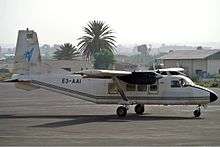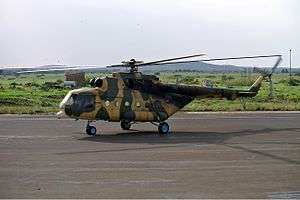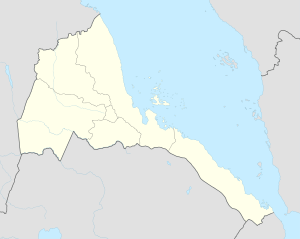Eritrean Air Force
The Eritrean Air Force (ERAF) is the official aerial warfare service branch of the Eritrean Defence Forces and is one of the three official uniformed military branches of the State of Eritrea.
| Eritrean Air Force | |
|---|---|
| Founded | 1994 |
| Country | |
| Type | Air force |
| Role | Aerial warfare |
| Size | 45 aircraft |
| Headquarters | Asmara, Eritrea |
| Colors | Green, Blue, Yellow and Red |
| Commanders | |
| Commander | Teklai Habteselassie |
| Insignia | |
| Roundel |  |
| Fin flash | |
| Aircraft flown | |
| Attack | MB-339, Mi-24, Su-25 |
| Fighter | MiG-21, MiG-29, Su-27 |
| Trainer | M-290 |
| Transport | An-12, Y-12, Mi-8 |
History
The Eritrean Air Force was established shortly after Eritrean War of Independence in 1994. It was first established by Commander Habtezion Hadgu, who used to be an Ethiopian Air force pilot during the Mengistu regime, and later defected to the Eritrean People Liberation Front (EPLF) in the late 1980s. When the air force was established, Commander Hadgu called many officers who served in the Ethiopian Air force, including Col. Abrahan (Chief of Staff), Col. Melake, Col. Mesfin, Col. Dr. Efrem and some others, like Major Shekay who came from Lebanon. His deputy was a veteran EPLF fighter, a Major General, Aka. Wedi Kahsay until he was sent to the northern zone as a commander of a regiment in the army. The director of Air Force Intelligence and Administration was also a veteran EPLF fighter, Col. Mussie Lebassi, a member of the 72nd intelligence unit of the EPLF, which was dissolved in 1994. Commander Habtezion and Col. Mussie were later suspended form the air force. Eventually, the air force was taken over by Major General Teklay Habteselasie who is also the commander of the Sawa military training camp.
The make-up of the original force was composed of aircraft that were abandoned by the defeated Ethiopian armed forces. The Eritrean Air Force is a smaller branch of the Eritrean Defence Forces. Several MiG-21s which were taken from the Ethiopian Air Force are believed to be no longer in service. The main airbase is Asmara AP, which is a combined civil/military base. Serials are sometimes, but not always, worn with 'ERAF' in front of the digits.
The air force has experienced a number of notable defections in recent years. In 2012 two high-ranking officers flew the air force's only luxury airplane out of the country to Saudi Arabia and sought asylum.[1]
1998–2000 Eritrean-Ethiopian War

Expansion of the Eritrean Air Force (ERAF) did not occur until the Eritrean-Ethiopian War in which the two air forces fought for superiority. In a sort of arms race Eritrea responded to Ethiopia's purchase of Su-27s with a purchase of MiG-29s.[2][3] In 2000 the ERAF bought eight Su-25s from Georgia, and six more MiG-29s from Moldova. In 2003 Eritrea also acquired several Su-27s.[4] The Eritrean Air force trained and grew enormously in a short period and was able to challenge the Ethiopian army in the 1998 border conflict. Commander Habtezion, along with young Air Force pilots, retaliated in short time after the Ethiopian Air force, led by popular pilot General Bezabh Petros - in captivity during the liberation war and recaptured again in the 1998 war - bombed Asmara.
Organization
The Commander of the Eritrean Air Force is Major General Teklai Habteselassie. The official headquarters of the Eritrean Air Force is located in Asmara, Eritrea.[5]
Aircraft
Current inventory

| Aircraft | Origin | Type | Variant | In service | Notes | |
|---|---|---|---|---|---|---|
| Combat Aircraft | ||||||
| MiG-29 | Russia | multirole | 5[6] | |||
| Sukhoi Su-27 | Russia | multirole | 4[6] | one used for conversion trainer | ||
| Transport | ||||||
| Super King Air | United States | utility | 200 | 1[6] | ||
| Harbin Y-12 | China | transport | 4[6] | |||
| Helicopters | ||||||
| Mil Mi-17 | Russia | utility / transport | 6[6] | |||
| Mil Mi-24 | Russia | attack | Mi-24/35 | 6[6] | ||
| Bell 412 | United States | utility | 1[6] | |||
| Trainer Aircraft | ||||||
| Aermacchi MB-339 | Italy | jet trainer | 6[6] | |||
Due to the lack of technical expertise with Russian aircraft, the Eritrean government maintained a contractual agreement with a Russian parastatal defense company to help upkeep its fleet of Russian manufactured fighter aircraft such as the MiG-29 and Su-27. However this agreement ended since it was in violation of United Nations Security Council Resolution 1907 barring military technical assistance to Eritrea. It is believed that Eritrea's fleet of Russian fighter aircraft is suffering from a chronic lack of maintenance and as a result rarely fly.[7]
References
- Rosen, Armin. "Why Two Eritrean Pilots Went Rogue and Stole Their President's Plane". The Atlantic. Retrieved 27 October 2016.
- "Eritrean Republic Air Force Overview". Scramble. Archived from the original on 7 March 2007. Retrieved 9 March 2007.
- Habte-Giorgis, Berhe (19 March 1999). "[DEHAI] capturing a helicopter". Dehai. Archived from the original on 2 November 2013. Retrieved 19 May 2012.
- "Sukhoi Su-27 'Flanker' – Operator List". Retrieved 9 March 2007.
- "Eritrea Aircraft". Retrieved 8 June 2006.
- "World Air Forces 2020". Flightglobal Insight. 2020. Retrieved 10 March 2020.
- ERITREA'S AIR FORCE, SANCTIONS, AND RUSSIA (16 February 2010) https://wikileaks.org/plusd/cables/10ASMARA35_a.html
Further reading
- Cooper, Tom; Weinert, Peter (2010). African MiGs: Volume I: Angola to Ivory Coast. Harpia Publishing LLC. ISBN 978-0-9825539-5-4.
